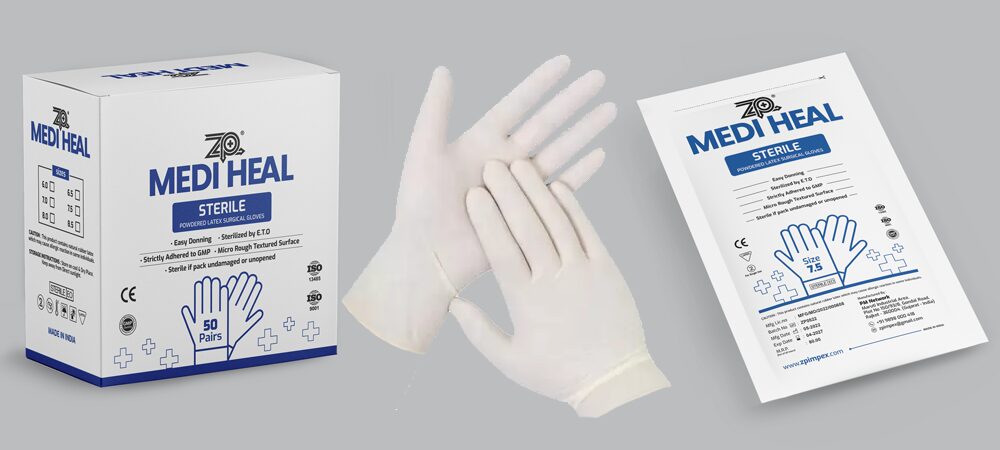
Healthcare requires precision and hygiene, thus Sterile Surgical Gloves are vital. These basic clothes are hospitals’ primary barrier against disease contamination, infection, and cross-transmission. Sterile gloves increase surgery and exam room patient safety, results, and quality.
Precision and hygiene-focused healthcare uses sterile gloves to protect patients and providers. Sterile gloves keep surgery sterile. Sterile gloves remain sterile until used due to rigorous sterilization and individual packaging. We’ll discuss Sterile Surgical Gloves uses, characteristics, and correct use below. We’ll also answer typical sterile and non-sterile glove questions.
Construction and composition:
Sterile Surgical Gloves made of latex, nitrile, and neoprene are excellent. Durability, flexibility, and sterility were considered when selecting these materials. Advanced methods ensure glove thickness, texture, and ergonomic design uniformity.
The sterilizing process:
All live organisms, including bacterial and fungal spores, are removed during sterilization. Chemotherapy and surgery necessitate sterile gloves. MCR Safety only sells non-sterile gloves, but consumers must grasp the distinctions to choose and wear the right product.
Before packaging, sterile gloves are sterilized to eradicate surface microorganisms. This treatment uses heat, radiation, or chemicals for high sterility. The gloves are sterilized and wrapped in sterile pouches or wrappers until use.
Application and Use:
The surgery uses Sterile Surgical Gloves to prevent infection. Separating the surgeon’s hands from the surgical site prevents contamination and infections. Invasive surgeries and diagnostic tests may necessitate sterile gloves.
Important for Infection Control:
Infection control requires sterile gloves. Sterile gloves prevent germs from moving from healthcare workers to patients and vice versa in surgical settings, when even minor sterility breaches can be disastrous. By keeping the field sterile, sterile gloves reduce post-operative infections and enhance patient outcomes.
Regulation compliance:
First line of defense against infection and contamination for medical staff is sterile gloves. These gloves clean operating rooms and exam rooms and improve patient care. Clean gloves show healthcare personnel’ commitment to patient care and ethics.
Now we will discuss sterile gloves’ varied uses and value in modern healthcare.
1. Barrier to infection: Pathogen protection is the sterile gloves’ principal function. Sterile gloves protect the inner sanctum from contaminants, reducing SSIs and other post-operative issues. Sterile gloves prevent doctors and patients from spreading infectious agents during medical procedures.
2. Sterility Preservation: Gloves are packaged well and sterilized to maintain purity till use. Each pair is sealed in a sterile pouch until doctors put them on. Cross-contamination avoidance and surgical sterile fields require sterility preservation.
3. Facilitating Hygienic Practice: Sterile gloves protect patients from infection and promote healthcare hygiene. Healthcare providers use sterile gloves to prevent infection and protect patients and staff.
4. Improved Surgical Precision: Sterile gloves enable confident and precise procedures. These gloves allow surgeons to operate delicate tissues and equipment with ease, lowering the risk of injury and improving surgical outcomes.
5. Occupational Hazard Protection: Healthcare workers face needle stick, body fluid, and chemical exposure risks. Sterile gloves safeguard frontline workers and decrease occupational injuries and infections.
6. Compliance with regulations: Global regulatory agencies, such as the FDA and WHO, mandate sterile gloves. Healthcare regulatory compliance requires sterile gloves for patient safety and quality.
7. Trust building: Patients trust healthcare providers to give quality care, and sterile gloves are seen as a show of professionalism. Strong infection control practices soothe patients and build healthcare system trust.
8. Healthcare Setting Adaptability: Sterile gloves are utilized in surgical theatres, emergency rooms, outpatient clinics, and dental offices. Healthcare providers in every clinical environment need their agility and adaptability.
9. Promoting Best Practices: Sterile gloves promote infection prevention, patient safety, and quality improvement in healthcare. Implementing sterile glove protocols in clinical operations shows healthcare excellence and quality improvement.
10. Overall Patient Care Contribution: Sterile gloves serve other purposes beyond protection. Critical patient care components enable clinical actions, reduce risks, and protect patients throughout their healthcare journey.
Finally, Sterile Surgical Gloves improve infection control, surgical precision, workplace safety, regulatory compliance, and patient confidence. Healthcare providers show patient safety and care with sterile gloves.
Sterile gloves lower infection risk for patients and clinicians in all healthcare settings. Surgical site infection is a common and significant perioperative complication, making this crucial. Corn-starch-dusted natural rubber latex gloves are typical. However, frequent latex glove use can cause latex allergy. Latex allergies can interfere with productivity, cost money, and even kill.